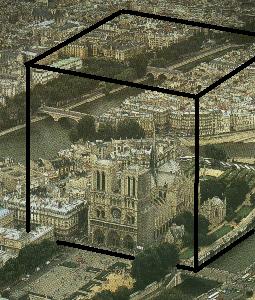 John-R.
Hendricks (Regina, Saskatchewan, Canada, 1929 - Victoria, BC, Canada, 2007)
John-R.
Hendricks (Regina, Saskatchewan, Canada, 1929 - Victoria, BC, Canada, 2007)Multimagic cubes
 John-R.
Hendricks (Regina, Saskatchewan, Canada, 1929 - Victoria, BC, Canada, 2007)
John-R.
Hendricks (Regina, Saskatchewan, Canada, 1929 - Victoria, BC, Canada, 2007)
Why limit oneself to 2 dimensions of multimagic squares? The Canadian John-R. Hendricks, the world's foremost expert on magic squares, created in June 2000 the first known bimagic cube. So, this bimagic cube is also the first known multimagic cube. His remarkable cube is 25th-order (=25x25x25 sized), and contains all the numbers from 1 to 15,625. The magic sum is 195,325, and the bimagic sum is 2,034,700,525. Holger Danielsson has created a PDF document (510Kb) giving details of this cube. See the biography of John R. Hendricks. See also another biography published in the Journal of Recreational Mathematics.
However, I have big doubts on the paternity of this cube. In his "The
Magic Square Course", second edition 1992 (very limited distribution as
was the first edition 1991, only
few photocopied samples), John-R. Hendricks wrote page 411 :
"David
M. Collison, in an unpublished paper, has constructed a bimagic cube of order
25 (....) but it takes too much space to show here."
Look
at page 411. We may think from this text that John had actually
received the cube. And exactly the same order 25, a very strange coincidence!
David M. Collison (1937 - 1991), an Englishman, was living in Anaheim, California:
often mentioned in "The Magic Square Course", he sent a lot of discoveries
directly to John, and died one year before this second edition. When John
published the cube in 2000, he strangely forgot to mention that David had
previously constructed such a cube...
In 2003, new multimagic cubes were constructed, thus giving now the following list of the smallest known cubes, for each multimagic level:
|
Cube |
Order |
File to be downloaded |
Magic degree of rows, columns, pillars |
Magic degree |
Magic degree |
|
Bimagic |
16 |
2 |
2 |
1 |
|
|
25 |
1 |
||||
|
27 |
3 |
1 |
|||
|
Perfect bimagic |
32 |
2 |
|||
|
Trimagic |
64 |
3 |
3 |
2 |
|
|
Perfect trimagic |
256 |
Too big to be downloaded! |
3 |
||
|
Tetramagic |
1024 |
4 |
4 |
3 |
|
|
Perfect tetramagic |
8192 |
4 |
(*) All the cubes were created in 2003 by Christian Boyer, except this bimagic cube of order 25 created in 2000 by John R. Hendricks or before 1991 by David M. Collison.
The bimagic cube of order 16 uses the numbers from 0 to 4095. The magic sum is 32,760, and the bimagic sum is 89,445,720. The 256 rows, 256 columns, 256 pillars and 4 triagonals (= the 4 main space diagonals) are bimagic. Since it is not necessary by the definition of a standard magic cube, the 96 diagonals of the various squares making up the bimagic cube are not bimagic. Therefore they are magic. Thanks to Harvey Heinz (Canada), Aale de Winkel (Netherlands) and Walter Trump (Germany) who verified the bimagic characteristics of the cube as soon as it was announced in January 2003.
The trimagic cube of order 64 uses the numbers from 0 to 262,143. The 4096 rows, 4096 columns, 4096 pillars and 4 triagonals are trimagic. The 384 diagonals are bimagic.
A trimagic cube of order 256 has also been created: it is "perfect", since all its diagonals are trimagic. This cube is a monster: it contains the numbers from 0 to 16,777,215, with for example the trimagic sum S3 = 302231418874861348454400. Thanks to Walter Trump (Germany) who verified the trimagic characteristics of these cubes as soon as they were announced in February 2003.
Eric Weisstein (USA) also checked this perfect trimagic cube of order 256 using Mathematica on Dec 6, 2003 and confirmed its properties. The check took 30 minutes on a 1GHz Macintosh G4.
Then tetramagic cubes even more monstrous have been created, checked by Renaud Lifchitz (France) and Yves Gallot (France). See some details about these two persons in the hypercubes page.
About the perfect tetramagic cube 8192, its 67,108,864 rows, 67,108,864 columns, 67,108,864 pillars, 4 triagonals, and 49,152 diagonals are tetramagic. Its magic sums are :
In honour of the year 2003 when all of the above multimagic cubes were created, all these cubes start with the number "2003" in their first corner!
In the September 2003 issue of Pour La Science, the French edition of Scientific American, I published an article about the history of magic cubes and about the construction of multimagic cubes. It is stated for example that my perfect tetramagic cube of order 8,192 is:

The perfect tetramagic cube of order 8,192 can easily include Notre-Dame de Paris!
|
I dedicate the tetramagic cubes to Gaston Tarry and André Viricel. Gaston Tarry, inventor of the term "tetramagic", is the first man to have constructed a trimagic square, in 1905. It was of order 128. He is also the first man to have proved the famous Euler conjecture of the 36 officers. And my old friend André Viricel is the man who has invented a powerful method to construct trimagic squares of order 32. All my multimagic constructions are based on the ideas of Gaston Tarry (later improved by General Cazalas) and André Viricel, ideas simply enhanced to work with higher order and higher dimensions, cubes and hypercubes. Christian Boyer |
An anecdote found in the book Carrés Magiques au degré n, by Général Cazalas, 1934. Page 13, in the preface written by Auguste Aubry, we read that Gaston Tarry was preparing "a panmagic and trimagic cube that he had not the time to achieve" before he died in 1913. There is alas no trace of this work!
The Général Cazalas, although smart enough to construct his 64th-order
trimagic square, later failed in his attempt to construct a bimagic
cube. It is interesting to note that it was precisely focused, like John-R. Hendricks
and David M. Collison,
on the order 25. Cazalas wrote in 1934 in Sphinx (pages
168-169):
"... but the simplest bimagic cube is on the domain of the theory,
because his order is too big: in a 25th-order cube, we even get
only a very incomplete bimagic".
So, John-R. Hendricks / David
M. Collison proved to be more cunning than Cazalas!
Zhong Ming's perfect bimagic cubes of orders 16 and 25

 Zhong Ming (on the right, with his son and his daughter in 2015)
Zhong Ming (on the right, with his son and his daughter in 2015)
The above bimagic cubes of orders 16 and 25 are bimagic, but not perfect bimagic. My smallest perfect bimagic cube was big: of order 32, constructed in 2003.
In April 2015, Zhong Ming succeeded in constructing perfect bimagic cubes of orders 16 and 25; they are the new smallest known perfect bimagic cubes! Zhong Ming is a mathematics teacher, at Sichuan Dazhou Daxian, Pavilion Town Center School of China.
|
Cube |
Order |
File to be downloaded |
Magic degree of rows, columns, pillars |
Magic degree |
Magic degree |
|
Bimagic |
16 |
2 |
2 |
2 |
|
|
25 |
3 |
Return to the home page http://www.multimagie.com